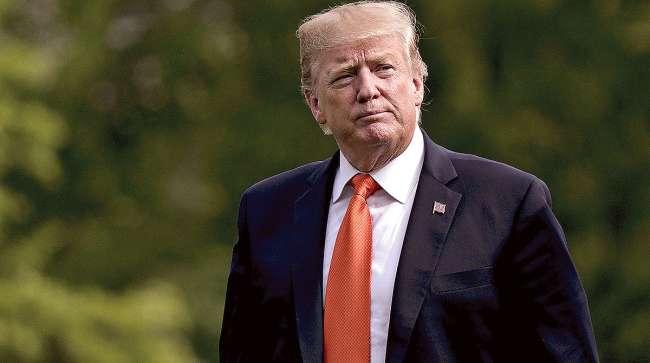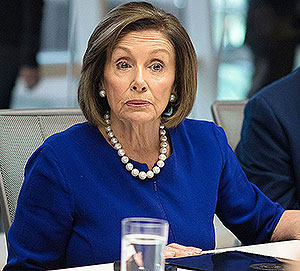Senior Reporter
Impeachment, Infrastructure, HOS to Dominate 2020

[Stay on top of transportation news: Get TTNews in your inbox.]
With the threat of an impeachment trial looming in 2020, the Trump White House challenged congressional leaders to instead shift their focus to issues confronting the country in the year ahead — including some that matter a great deal to the trucking industry.
President Donald Trump in a Dec. 17, 2019, letter to Speaker Nancy Pelosi (D-Calif.) outlined a list of initiatives undertaken during his presidency that he said warrant more attention than his looming impeachment trial. Among them was a new trade agreement with Canada and Mexico.
“There is far too much that needs to be done to improve the lives of our citizens,” Trump said.

House Speaker Nancy Pelosi by Kholood Eid/Bloomberg
Missing from his list was a long-term plan to fund upgrades to the nation’s transportation system. While Trump and congressional Democrats met during the spring to discuss a plan, negotiations collapsed with each side blaming the other.
Against the backdrop of the pending impeachment, counselor to the president Kellyanne Conway said now is the time to return to the issue.
“Shouldn’t we also be looking at the infrastructure package that Nancy Pelosi huffed and puffed and tried to blow our house down here — and walked out from the infrastructure meeting,” Conway told reporters Dec. 17.
Trump on May 22 told reporters at the White House that a scheduled meeting that day on infrastructure between himself, Pelosi and Senate Minority Leader Chuck Schumer (D-N.Y.) came to a halt after he raised concerns about ongoing congressional investigations into his 2016 campaign.
“I walked into the room, and I told Senator Schumer, Speaker Pelosi, ‘I want to do infrastructure. I want to do it more than you want to do it. I’d be really good at that. That’s what I do. But you know what. You can’t do it under these circumstances. So get these phony investigations over with,’ ’’ Trump said.

Enrique Pena Nieto, Donald Trump and Justin Trudeau by Sarah Pabst/Bloomberg News
Despite the recent calls for action, the odds of advancing a complete infrastructure package this year look slim.
Transportation policy, however, is expected to receive meaningful debate in the House of Representatives around springtime. That’s when the Transportation and Infrastructure panel intends to take up a multiyear highway measure that would update the 2015 FAST Act, which expires next fall. This legislation is expected to propose policies central to freight corridors and transit systems, as well as autonomous vehicles and climate-resilient infrastructure. A Senate committee has already advanced its version.
However, neither the House nor the Senate bills are expected to address the looming shortfall of the Highway Trust Fund, the account backed by revenue from federal fuel taxes that assists states with road maintenance and construction. Federal taxes on diesel and gasoline have remained stagnant since 1993, and are insufficient to keep the fund solvent.
Stakeholders are pressuring lawmakers to act. “We urge our elected officials to think beyond the next election. America’s future depends on modern transportation infrastructure. Failure isn’t good,” Ed Mortimer, U.S. Chamber of Commerce vice president of transportation infrastructure, said late last year.
Jim Tymon with the American Association of State Highway and Transportation Officials reminded policymakers last month that infrastructure investment remains a bipartisan priority for voters.
“A crucial step we can take to harness this momentum is to complete the FAST Act reauthorization before October 2020 without relying on any short-term extensions,” said Tymon. “To do this, the situation demands bold action to invest in our transportation infrastructure at the appropriate level to guarantee the success of our nation’s future.”
Meanwhile, after the impeachment trial the Senate is expected to vote on the new United States-Mexico-Canada Agreement. Trucking, freight rail and labor and business groups have applauded the agreement, which was negotiated by Pelosi and Trump’s team. “The vast majority of trade in North America moves on truck, with $772 billion worth of goods crossing our borders with Mexico and Canada every year. USMCA will provide the certainty our industry needs while ensuring the United States remains competitive on the world stage,” American Trucking Associations President Chris Spear said last year.
In the fall, presidential politics will likely dominate mainstream media. If acquitted in the Senate, Trump would be the first incumbent to seek another term after being impeached by the House.
Democrats have a broad field of opponents for the commander in chief, but neither party has touted infrastructure during the run-up to the election.

Collins
In Congress, Sen. Susan Collins (R-Maine), the chamber’s top transportation funding policymaker, announced plans for re-election.
On the regulatory front, drivers and motor carriers are anticipating a final rule on a proposal that would give drivers more flexibility with hours of service in their workdays — and the rule could be issued sometime in the first quarter, according to Dan Horvath, ATA’s director of safety policy. The proposal is currently being reviewed by the White House Office of Management and Budget.
The proposed rule would allow truck drivers more flexibility with their 30-minute rest break and how to divide their time in the sleeper berth. It also would extend by two hours the duty time for drivers encountering adverse weather and extend the shorthaul exemption by lengthening drivers’ maximum on-duty period from 12 hours to 14 hours and increasing the distance limit in which drivers can operate from 100 air miles to 150 air miles.
Another more controversial provision of the HOS proposal would allow drivers to take a break for up to three hours.
Horvath said he thinks four of the five provisions would likely be kept in the rule.
“The one with the biggest question marks is the split-duty day concept allowing drivers to pause their clock for 30 minutes up to three hours in a given duty day,” Horvath said. That proposal has drawn criticism over fears that shippers could take advantage of a driver’s work day and make drivers use it for detention time. “We want whatever changes happen to benefit the driver, not shippers,” he added.
Horvath believes the shorthaul provision will make the cut, but wonders if both proposed options will be included. “They may not do both,” he said. “They may just address the mileage, they may just look at the change in on-duty time, or both.”
Horvath also said he expects the adverse driving two-hour extension to be in the final rule because it’s an easy way for the agency to provide flexibility. Additionally, he said he expects the 30-minute rest break and split sleeper berth of 7-3 and 8-2 hour splits also will make the cut.
FMCSA also has made efforts to target young people for potential trucking jobs, via the Under 21 Military Driver Pilot Program. However, the federal Entry Level Driver Training (ELDT) rule has encountered delays. FMCSA officials have reported that they are preparing a formal notice to delay implementation of the ELDT rule by up to two years after it was set to go into effect on a limited basis Feb. 7.
Don Lefeve, president of the Commercial Vehicle Training Association, said the delays associated with the ELDT rule may slow any efforts to lower the interstate truck driving age. Federal law prohibits 18- to 20-year-olds from driving Class 8 trucks across state lines.
“I think you’re going to have to have a training rule in place before the FMCSA would grant 18-year-olds the right to cross state lines,” Lefeve said. “The entry-level driver rule is kind of the bedrock from which all these things can grow.”
CVTA and ATA support the Developing Responsible Individuals for a Vibrant Economy, or DRIVE-Safe Act, which proposes a two-step program for prospective young drivers to complete once they obtain a commercial driver license.
Larry Marsh, chairman of the CVTA Board of Directors and owner of the Omaha, Neb.-based JTL Truck Driver Training school, said the legislation makes sense for larger states like Nebraska. He pointed out that a trucker below the age of 21 can drive 400 miles across Nebraska, but can’t drive the 20 miles between Omaha and Council Bluffs, Iowa.
Marsh noted that young people may be attracted to other trades because of the interstate trucking age rules.
“With younger drivers, you’ve got to get them into the industry before they take off on a different career path,” Marsh said. “Those individuals who are 18 and look at truck driving as a possible career are usually a little bit more focused on what they want to do. It’s not just a fallback for someone who’s lost a job.”
https://t.co/th4zdLkyDG pic.twitter.com/V7QNUPkX7G — FMCSA (@FMCSA) December 23, 2019
Also on the regulatory radar is a long-awaited Drug and Alcohol Clearinghouse regulation slated to take effect Jan. 6. It is expected to make it more difficult for truck and bus drivers to hide a drug test failure from a prospective employer. The Clearinghouse will require employers to list truck and bus drivers who have failed or refused to take DOT drug tests, and the results for drivers required to complete a return-to-duty program and clean drug test.
The new rule could make the trucking industry as a whole safer, according to Abigail Potter, manager of safety and occupational health policy for ATA.
“The implementation of the Clearinghouse is going to close the job loophole within the drug-testing regulation that has existed since the mid-’90s,” Potter said. “This is a step to ensure that all individuals who have DOT drug and alcohol violations are meeting the standard.”
In 2020, experts expect the trucking industry’s battle to employ drivers as independent contractors to continue. Efforts to challenge the industry’s traditional business model already are under heavy fire in such states as California – where a state law is under a temporary stay — as well as New Jersey, and could spread to states such as Washington, Illinois and Colorado, according to Greg Feary, a partner in the Indianapolis-based trucking law firm Scopelitis, Garvin, Light, Hanson & Feary.
“These are what I call paternalistic leaning states that for some reason — maybe being encouraged by organized labor — believe that workers need to be protected from their own decisions to be independent contractors,” Feary said.
Judge grants request for temporary restraining order, enjoining enforcement of #AB5 against California truckers pending resolution of @Caltrux motion for preliminary injunction. https://t.co/BpE84lIV5N — CA Trucking Assoc. (@Caltrux) January 1, 2020
At the heart of the contractor versus employee debate is the so-called “ABC test” adopted in California and New Jersey. Truckers have said the test makes it difficult, if not impossible, to continue the use of independent contractors. The B-prong of the ABC test is the most troublesome, carriers have said; it dictates that for a motor carrier to establish that a worker is an independent contractor that the worker must perform work that is outside the usual course of the hiring entity’s business.
The New Jersey Department of Labor and U.S. Department of Labor signed a joint agreement to step up efforts to combat classification of certain workers — including truck drivers — as independent contractors. The agreement and other efforts by New Jersey Labor Department officials have turned the Garden State into a “misclassification battlefront,” according to Feary.
“I think motor carriers are just going to have to understand how state governments interpret independent contractor relationships so they can structure programs to meet that interpretation,” Feary said. “That’s a high hurdle now in states that are adopting ABC tests across the board.”
Staff reporters Eleanor Lamb and Eric Miller contributed to this article.
Want more news? Listen to today's daily briefing:

